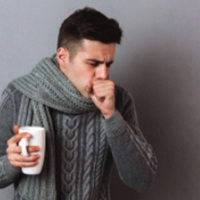Non-pharmacological remedies for post-viral acute cough

Submitted: February 25, 2021
Accepted: June 13, 2021
Published: August 10, 2021
Accepted: June 13, 2021
Abstract Views: 9646
PDF: 4417
Publisher's note
All claims expressed in this article are solely those of the authors and do not necessarily represent those of their affiliated organizations, or those of the publisher, the editors and the reviewers. Any product that may be evaluated in this article or claim that may be made by its manufacturer is not guaranteed or endorsed by the publisher.
All claims expressed in this article are solely those of the authors and do not necessarily represent those of their affiliated organizations, or those of the publisher, the editors and the reviewers. Any product that may be evaluated in this article or claim that may be made by its manufacturer is not guaranteed or endorsed by the publisher.
Similar Articles
- Muhammad Ijaz, Muhammad Jaffar Khan, Jawad Khan, . Usama, Association of clinical characteristics of patients presenting with influenza like illness or severe acute respiratory illness with development of acute respiratory distress syndrome , Monaldi Archives for Chest Disease: Vol. 87 No. 1 (2017)
- Massimiliano Polastri, Lara Pisani, Andrea Dell'Amore, Stefano Nava, Revolving door respiratory patients: A rehabilitative perspective , Monaldi Archives for Chest Disease: Vol. 87 No. 3 (2017)
- Gabriele Valli, Francesca De Marco, Maria Teresa Spina, Valentina Valeriano, Antonello Rosa, Valentina Minerva, Enrico Mirante, Maria Pia Ruggieri, Francesco Rocco Pugliese, A pilot study on the application of the current European guidelines for the management of acute coronary syndrome without elevation of ST segment (NSTEMI) in the Emergency Department setting in the Italian region Lazio , Monaldi Archives for Chest Disease: Vol. 82 No. 4 (2014): Cardiac series
- Roberto F.E. Pedretti, Francesco Fattirolli, Raffaele Griffo, Marco Ambrosetti, Elisabetta Angelino, Silvia Brazzo, Ugo Corrà , Nicolò Dasseni, Pompilio Faggiano, Giuseppe Favretto, Oreste Febo, Marina Ferrari, Francesco Giallauria, Cesare Greco, Manuela Iannucci, Maria Teresa La Rovere, Mario Mallardo, Antonio Mazza, Massimo Piepoli, Carmine Riccio, Simonetta Scalvini, Luigi Tavazzi, Pier Luigi Temporelli, Gian Francesco Mureddu, Cardiac Prevention and Rehabilitation “3.0â€: From acute to chronic phase. Position Paper of the ltalian Association for Cardiovascular Prevention and Rehabilitation (GICR-IACPR) , Monaldi Archives for Chest Disease: Vol. 88 No. 3 (2018)
- Carlos A. Jiménez-Ruiz, Marcos Garcia Rueda, Manuel A. Martinez Muñiz, Jacobo Sellarés, Maria A. Jiménez-Fuentes, Lourdes Lázaro Asegurado, Esther RodrÃguez Gonzalez, Concepción Rodriguez Garcia, Oriol Armengol, Emilia Abad, Teresa Peña, Adolfo Domenech del Rio, Juan A. Riesco Miranda, Varenicline in smokers with severe or very severe COPD after 24 weeks of treatment. A descriptive analysis: VALUE study , Monaldi Archives for Chest Disease: Vol. 87 No. 3 (2017)
- P.A. Canessa, L. Pratticò, M. Sivori, P. Magistrelli, F. Fedeli, A. Cavazza, G. Calcina, Acute Fibrinous and Organising Pneumonia in Whipple’s disease , Monaldi Archives for Chest Disease: Vol. 69 No. 4 (2008): Pulmonary series
- A.G. Corsico, S. Villani, M.C. Zoia, R. Niniano, E. Ansaldo, G. Cervio, P.M. Quaresima, E. Gatto, E. Crippa, A. Marinoni, A. Foresi, E. Pozzi, I. Cerveri, Chronic productive cough in young adults is very often due to chronic rhino-sinusitis , Monaldi Archives for Chest Disease: Vol. 67 No. 2 (2007): Pulmonary series
- William Newmarch, Angelica Puopolo, Madina Weiler, Brian Casserly, Hamman-Rich syndrome: a forgotten entity , Monaldi Archives for Chest Disease: Vol. 87 No. 1 (2017)
- A. Chetta, M. Aiello, P. Tzani, D. Olivieri, Assessment and monitoring of ventilatory function and cough efficacy in patients with amyotrophic lateral sclerosis , Monaldi Archives for Chest Disease: Vol. 67 No. 1 (2007): Pulmonary series
- Giorgio Berlot, Antonella Vergolini, Cristina Calderan, Rossana Bussani, Lucio Torelli, Umberto Lucangelo, Acute myocardial infarction in non-cardiac critically ill patients: a clinical-pathological study , Monaldi Archives for Chest Disease: Vol. 74 No. 4 (2010): Cardiac series
You may also start an advanced similarity search for this article.

 https://doi.org/10.4081/monaldi.2021.1821
https://doi.org/10.4081/monaldi.2021.1821





